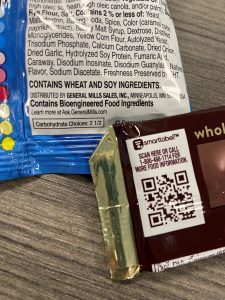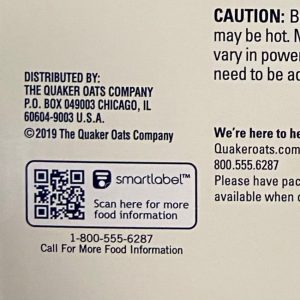What do you need to know with new food packaging labels?
By Katie Zelechowski Illinois Farm Bureau — March 8, 2022

Starting this year, regulated food manufacturers, importers and certain retailers must disclose the presence of bioengineered ingredients via text, symbol, electronic or digital link, and/or text message to consumers. (Photo by Katie Zelechowski of Illinois Farm Bureau)
Didn’t think companies could fit one more label on food packaging covered from front to back in emblems and claims? Guess again.
Thanks to a recent labeling law, companies must indicate the presence of bioengineered food or ingredients on product packaging. Two moms and food sector experts explain what the new labels mean for grocery shoppers, and the technology behind them.
“I’m a mom of young kids myself. I’ve got an almost 6-year-old and an almost-2-year-old so, I completely sympathize with moms and parents at the store who are just like ‘I don’t know what to feed my kid’,” said Leia Flure, a registered and licensed dietitian and University of Illinois Extension nutrition education specialist.
Congress passed the National Bioengineered Food Disclosure Law in 2016, with a mandatory compliance date of this year. Administered by the U.S. Department of Agriculture (USDA), the standard ensures food manufacturers disclose whether foods contain or may contain bioengineered, also known as genetically modified or GMO, ingredients using text or symbols on product packaging.
Shoppers might be surprised to learn that many of the products they’ve been eating for years have been improved through biotechnology. But the presence of new labels shouldn’t stop them from making the same purchase decisions.
“Scientific research has shown time and time again that bioengineered foods are just as safe as their non-engineered counterparts,” Flure said. She helps inform consumers about the science behind food production by contributing to GMOAnswers.com. She also consults for Bayer Crop Science.
For people who need a place to start, Flure suggests looking past random food package labels to read the nutrition facts panel on the back. That’s where consumers will find details about how products affect their health.
“I think it’s important to look for foods that are higher in fiber, higher in vitamins and minerals, and lower in things like saturated fat and sodium,” she said.
It’s also important to note that bioengineered labels don’t always apply to every ingredient in a product. A veggie pizza made with only two GMO ingredients will be labeled as genetically modified, even if the other ingredients might’ve been grown using organic or conventional products and practices.

According to the U.S. Department of Agriculture, the National Bioengineered Food Disclosure Standard “defines bioengineered foods as those that contain detectable genetic material that has been modified through certain lab techniques and cannot be created through conventional breeding or found in nature.” (Photo by Katie Zelechowski of Illinois Farm Bureau)
“I’m not entirely sure that bioengineered as a rebranding of GMO will be bought by consumers, literally and figuratively,” Flure said. “There might be some unintended consequences; I think it could potentially undermine people’s trust in the food system.”
While people might be unfamiliar with the terminology, innovative agricultural production techniques have been used for decades.
Sarah Gallo, vice president of agriculture and environment for the Biotechnology Innovation Organization (BIO), said biotechnology has continued to grow because more companies, farmers and even consumers recognize its benefits, like reducing food waste and decreasing the carbon footprint of growing food.
“We can always do a better job talking about those environmental benefits and how the pressure to continue to feed a population that’s growing is going to need to have innovation as part of the solution — and I think there’s a good history to demonstrate that,” Gallo said.
BIO’s member companies work across food systems, ag practices, biofuels and industrial-based processes to develop technology that improves products.
For example, biotechnology has been credited for saving the papaya from a devastating virus, seed that produces crops requiring less tillage and pesticides, and helping to lead the charge developing COVID-19 vaccines.
“Disruptive tech” developed by these, and other, companies continue to transform the American food system to increase food access and address climate change, according to Gallo.
“More of the technology that’s coming into the market on the food side, and even on the industrial side, is really consumer-focused,” Gallo said. “The reasons these products are coming to market are not only for the benefit of farmers but also for consumers and thinking about how they directly interact with the technology in their daily lives.”
This story was distributed through a cooperative project between Illinois Farm Bureau and the Illinois Press Association. For more food and farming news, visit FarmWeekNow.com.







